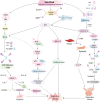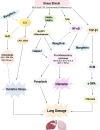Mangiferin Against Respiratory Diseases: Pharmacological Targets and Prospects
- PMID: 40783911
- PMCID: PMC12335824
- DOI: 10.1002/prp2.70163
Mangiferin Against Respiratory Diseases: Pharmacological Targets and Prospects
Abstract
Respiratory diseases are associated with high mortality worldwide. Respiratory infections can lead to the emergence of chronic respiratory diseases. Scientists are constantly striving to identify new therapies with reduced side effects. The rise of antibiotic resistance and the scarcity of effective treatments further necessitate the development of novel therapeutics specific to respiratory diseases. Extensive research has been conducted on natural products that could be effective against respiratory diseases. Mangiferin, a polyphenol with a C-glycosyl xanthone structure, is a bioactive phytochemical that has potential applications in the treatment of respiratory tract infections. Mangiferin could be a therapeutic option against respiratory diseases because of its ability to target a variety of pharmacological pathways implicated in the development of these infections. It has been shown to limit infections, lower inflammation, control immune responses, and enhance host defense mechanisms. This review provides comprehensive insight into mangiferin's potential against various respiratory disorders, focusing on its pharmacological activity and therapeutic prospects. Despite the potential of mangiferin against respiratory problems-related pathobiology, additional scientific validation through clinical trials is required before the clinical application of mangiferin in the management of respiratory diseases.
Keywords: Mangiferin; fibrosis; infections; inflammation; oxidative stress; respiratory diseases.
© 2025 The Author(s). Pharmacology Research & Perspectives published by British Pharmacological Society and American Society for Pharmacology and Experimental Therapeutics and John Wiley & Sons Ltd.
Conflict of interest statement
The authors declare no conflicts of interest.
Figures




Similar articles
-
Management of urinary stones by experts in stone disease (ESD 2025).Arch Ital Urol Androl. 2025 Jun 30;97(2):14085. doi: 10.4081/aiua.2025.14085. Epub 2025 Jun 30. Arch Ital Urol Androl. 2025. PMID: 40583613 Review.
-
The Black Book of Psychotropic Dosing and Monitoring.Psychopharmacol Bull. 2024 Jul 8;54(3):8-59. Psychopharmacol Bull. 2024. PMID: 38993656 Free PMC article. Review.
-
[Guidelines for the prevention and management of bronchial asthma (2024 edition)].Zhonghua Jie He He Hu Xi Za Zhi. 2025 Mar 12;48(3):208-248. doi: 10.3760/cma.j.cn112147-20241013-00601. Zhonghua Jie He He Hu Xi Za Zhi. 2025. PMID: 40050074 Chinese.
-
[Volume and health outcomes: evidence from systematic reviews and from evaluation of Italian hospital data].Epidemiol Prev. 2013 Mar-Jun;37(2-3 Suppl 2):1-100. Epidemiol Prev. 2013. PMID: 23851286 Italian.
-
Systemic Inflammatory Response Syndrome.2025 Jun 20. In: StatPearls [Internet]. Treasure Island (FL): StatPearls Publishing; 2025 Jan–. 2025 Jun 20. In: StatPearls [Internet]. Treasure Island (FL): StatPearls Publishing; 2025 Jan–. PMID: 31613449 Free Books & Documents.
References
-
- Moriyama M., Hugentobler W. J., and Iwasaki A., “Seasonality of Respiratory Viral Infections,” Annual Review of Virology 7, no. 1 (2020): 83–101. - PubMed
-
- Rahman M. D., Zahan M., Hasib T., et al., “Current Knowledge on Mechanisms Involved in SARS‐CoV‐2 Infection and Kidney Diseases,” Journal of Advanced Biotechnology and Experimental Therapeutics 3, no. 4 (2020): 30–35.
Publication types
MeSH terms
Substances
LinkOut - more resources
Full Text Sources

